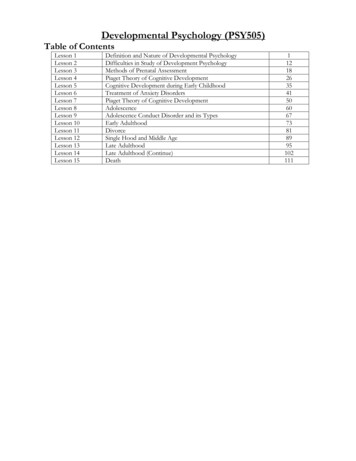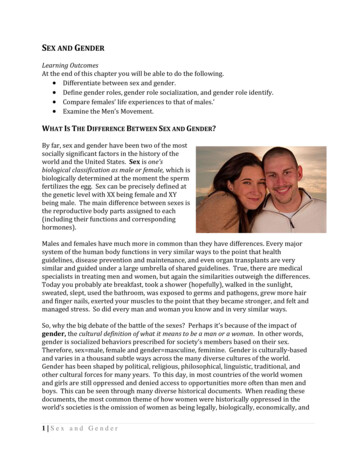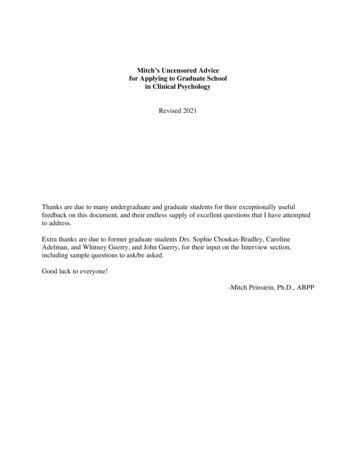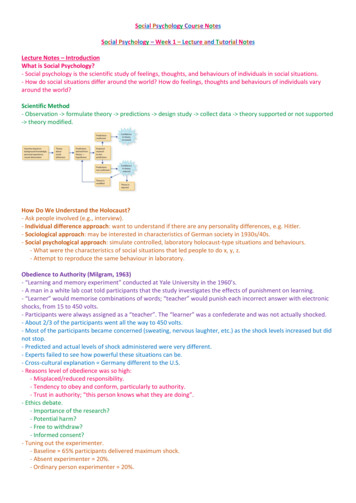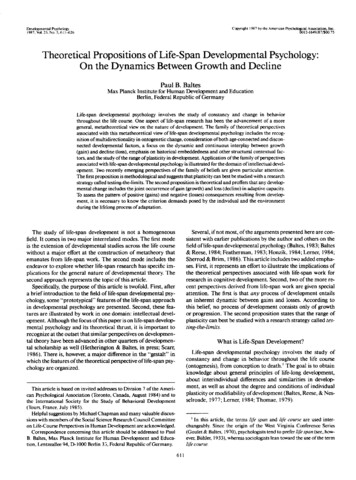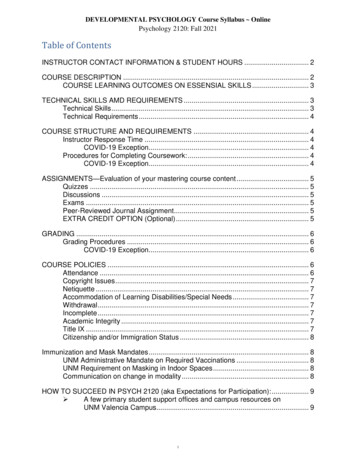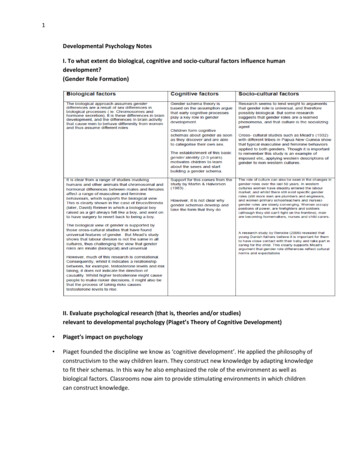
Transcription
1Developmental Psychology NotesI. To what extent do biological, cognitive and socio-cultural factors influence humandevelopment?(Gender Role Formation)II. Evaluate psychological research (that is, theories and/or studies)relevant to developmental psychology (Piaget’s Theory of Cognitive Development) Piaget’s impact on psychology Piaget founded the discipline we know as ‘cognitive development’. He applied the philosophy ofconstructivism to the way children learn. They construct new knowledge by adapting knowledgeto fit their schemas. In this way he also emphasized the role of the environment as well asbiological factors. Classrooms now aim to provide stimulating environments in which childrencan construct knowledge.
2 His theories have received a lot of support over many years, and whilst his theories have beensubject to modification and criticism many fundamental aspects of his theories are still acceptedas valid and relevant. Methodology Many of these criticisms concern his research methods. Piaget studied his own children and thechildren of his colleagues in Geneva in order to deduce general principles about the intellectualdevelopment of all children. Not only was his sample very small, but it was composed solely of European children fromfamilies of high socio-economic status. Researchers have therefore questioned thegeneralizability of his data. He used the term clinical interview to do his research. This took the form of an open endedconversational technique for testing children’s understanding of certain tasks. Although clinicalinterviews allow the researcher to explore data in more depth, the interpretation of theinterviewer may be biased. At the same time children may not understand the question/s, they have short attention spans,they cannot express themselves very well and may be trying to please the experimenter. Suchmethods meant that Piaget may have formed inaccurate conclusions. Competence Vs. Performance (over-under estimates) Piaget failed to distinguish between competence (what a child is capable of doing) andperformance (what a child can show when given a particular task). When tasks were altered,performance (and therefore competence) was affected. Therefore Piaget may have underestimated children’s cognitive abilities. For example a childmight have object permanence (competence) but still not be able to search for objects(performance). When Piaget hid objects from babies he found that it wasn’t till after 9 monthsthat they looked for it. While Piaget relied on manual search methods – whether the child was looking for the object ornot later research such as Baillargeon and Devos (1991), reported that infants as young as 4months looked longer at a moving carrot that didn’t do what it expected, suggesting they hadsome sense of permanence, otherwise they wouldn’t have had any expectation of what itshould or shouldn’t do. A further example is that of ‘egocentrism’. Egocentrism is the inability to see things fromanother’s perspective. In Piaget’s three-mountains task children up to aged nine were unable todescribe a mountain-top scene from another doll’s perspective.
3 Hughes ( 1975) argued that the task was both unrealistic ( mountain scene) and unmanageable (picking out photos). He tested egocentrism using a model of two intersecting walls, a doll of alittle boy and two ‘policeman’ dolls and the child is asked to hide the doll where neither of thepolicemen can see him. Hughes found that pre-school children selected a correct hiding placefor the boy 90% of the time. Even the youngest 122 children in the sample (3 ½ -4 years) got itright 88% of the time. This suggested young children are able to see things from another’sperspective. Similarly, Piaget found that conservation tasks, such conservation of volume (liquid) was hardfor children under the age of 7. However subsequent research, such as that by Samuel & Bryant(1984) found that children below that age of 7 were able to conserve. They argued that Piaget’spre-transformation question unwittingly forced children to give the wrong answer by asking thesame question post-transformation –according to the child a change of liquid must surelyrequire a change of answer. Role of social cultural factors As Piaget saw children as largely independent and isolated in their construction of knowledgeand understanding of the physical world he has been criticized for failing to emphasize the roleof social support and culture. Dasen (1994) cites studies he conducted in remote parts of the central Australian desert with 814 year old Aborigines. He gave them conservation of liquid tasks and spatial awareness tasks.He found that the ability to conserve came later in the aboriginal children, between aged 10 and13 (as opposed to between 5 and 7, with Piaget’s Swiss sample). However, he found that spatial awareness abilities developed earlier amongst the Aboriginalchildren than the Swiss children. Such a study demonstrates cognitive development is not purelydependent on maturation but on cultural factors too – spatial awareness is crucial for nomadicgroups of people. Vygotsky, a contemporary of Piaget argued that social interaction is crucial for cognitivedevelopment. According to Vygotsky the child's learning always occurs in a particular socialcontext in co-operation with someone more skilful. This social interaction provides language opportunities, language is the foundation of thoughtAll children have their own ZPD’s (Zone of Proximal Development) and it is only with guidancethrough that zone that cognitive development will occur. This is supported by studies such asMcNaughton & Leyland’s jigsaw study in which children could complete harder puzzles onlywhen aided by their mothers.Theory of Cognitive Development
4
5III. Discuss how social and environmental variables may affect cognitive development Diet Diet and nutrition is fast becoming a social issue as obesity rates increase in the USA and inEurope. But poor diet can also have effects on cognitive development as well as body mass.Northstone et al (2010) monitored 4,000 children in the UK from birth through to age 8. Research showed that children under the age of four who regularly ate processed food, fat andsugar had a lower intellectual performance at the age of eight and a half. According to the studythe children's IQ scores fell by 1.67 for every increase on a chart reflecting the amount ofprocessed fat in their diet Conversely the positive effects of a healthy diet have been well researched. Hibbeln et al.(2007) compared two groups of women (those consuming high levels of omega- 3 fatty acidsand those consuming low levels of the same). They found the children of those mothers who had a low seafood intake during pregnancy hadlower motor (movement and coordination) skills and lower social development andcommunication skills than the children of mothers who consumed high levels of seafood. Raloff(1989) studied 1023 6th-grade children over the course of one year and found those who weregiven free school breakfasts improved their math and science scores. Parenting In the USA, the Michigan Department of Education (MDE, 2002) argued that the mostconsistent predictors of a child's academic achievement and social adjustment were parentexpectations: parents of high-achieving students set higher standards for their children'seducational activities than parents of low-achieving students and this drove educationalachievement and therefore cognitive development. The MDE stated that when parents are involved, students have:
6 Higher grades, test scores and graduation rates Increased motivation and better self-esteem Better school attendance Lower rates of suspension Decreased use of drugs and alcohol Fewer instances of violent behavior. Family participation in education was twice as predictive of students' academic success as familysocio-economic status; the more intensely parents were involved, the more beneficial theachievement effects. For example, children who practice reading at home with their parents,make significant gains in reading achievement compared to those who practice only at school(Tizard et al., 1982). This has wider implications, as parents who read to their children are also more likely to havemore books available, take trips together as family, monitor TV watching, and providestimulating experiences which together contribute to cognitive development. Conclusion Evans & Schamberg (1994) It is unlikely that social and environmental factors alone can influence cognitive development.Schamberg & Evans (1994) argued it is an interaction of these factors with biological factors thatbest explain difficulties in cognitive development. They tested this hypothesis by using the results of an earlier, long-term study of stress in 195poor and middle-class Caucasian students, half male and half female. In that study, which founda direct link between poverty and stress, students’ blood pressure and stress hormones weremeasured at 9 and 13 years old. In this study, earlier participants, now aged 17, had their memory was tested. Working memoryis considered a reliable indicator of reading, language and problem-solving ability — capacitiescritical for adult success. Given a sequence of items to remember‚ teenagers who grew up inpoverty remembered an average of 8.5 items. Middle-class teenagers remembered an averageof 9.44 items. In lab animals, stress hormones and high blood pressure are associated with reduced cellconnectivity and smaller volumes in the prefrontal cortex and hippocampus. It’s in these brainregions that working memory is centered. Evans and Schamberg argued that the studydemonstrated that the stress associated with poverty had a negative effect on the cognitive
7development of poor children. However such a study is correlational, and does not imply causeand effect.IV. Examine attachment and its role in the subsequent formation ofrelationships Bowlby’s ethological / evolutionary theory Until the 1950s, most psychologists believed that babies become attached to their primary caregiver because they associate them in some way with being fed. However, Bowlby proposed that attachment was important not just for survival but emotionalsurvival and protection. He argued that infants are biologically predisposed (born) to formattachments and to seek attachment figures to protect them. The child forms a mental representation of their first attachment relationship - which he calledan internal working model. If the child internalizes a working model of attachment as secure,warm and reliable this serves as a schema for future relationships. Bowlby's theories had, and continue to have an enormous impact on child development,particularly in the area of parenting and social policy. He was influenced by the work of ethologists such as Harlow (1962), noting that other speciesapart from humans formed attachments. In Harlow’s study monkey’s infant monkey’s preferredto cling to a toweled wire monkey, than one that dispensed food. This study, although now considered unethical demonstrated the importance of comfort, evento monkeys. Furthermore animal studies are hard to generalize to humans. According to Bowlby infants display an innate tendency to become attached to one particularindividual. He called this monotropy. He suggested this tendency was qualitatively differentfrom any subsequent attachment a child might form. However, this has been challenged by Schaffer & Emerson’s (1964) study who found thatinfants in Glasgow had multiple attachments by the age of 18 months. These included fathers,brothers, sisters, grandparents and close neighbors. Bowlby argued there was a critical period for attachment, the first 2-3 years of life. He basedthis on the work of Karl Lorenz (1937) who observed that a newly hatched set of goslingsfollowed around the first object they saw – i.e. him (known as imprinting). Bowlby believed that if this bond is not formed, or is broken, then there would be permanentemotional damage because children only develop socially and emotionally when an attachmentprovides them with feelings of security.
8 This became known as the maternal deprivation hypothesis, which states that continualdisruption of the attachment between infant and primary caregiver (i.e. mother) could result inlong term cognitive, social, and emotional difficulties for that infant. To support his hypothesis, he studied 44 adolescent juvenile delinquents in a child guidanceclinic. Through interviews he diagnosed 32% (14) of the thieves as ‘affectionless psychopaths’(having no affection for others and no shame or sense of responsibility). 86% of these‘affectionless psychopaths’ had experienced a long period of maternal separation before the ageof 5 years (they had spent most of their early years in residential homes or hospitals and werenot often visited by their families. However it is important to bear in mind that the research wascorrelational and non-experimental. It contained gender and researcher bias. Mary Ainsworth: classifying and explaining types A number of researchers have expanded the work of Bowlby, to include identifying andclassifying attachment types and researching the factors associated with the development ofattachments. Ainsworth (1969) sought to develop a reliable method of measuring quality of attachment usinga laboratory procedure called the Strange Situation. It is still the most commonly used methodfor measuring the level of attachment between the infant and the mother. The rationale behind the Strange Situation is that infants display different behaviors towards theprimary caregiver and towards strangers according to the security of attachment. The StrangeSituation has eight episodes each lasting 3 minutes. Although every aspect of the participants’reactions are observed and videotaped, what’s most carefully attended to is the child’s responseto the mother’s return. Based on the Strange Situation, Ainsworth (1978) proposed three types of attachment
9 Type A – insecure attachment (avoidant) these children play independently and do not showdistress when the mother leaves nor make contact when she returns. Between 20-25% if Britishchildren ages 12-18 months are classified as type A Type B – secure attachment; these children play independently an do not show much distress inepisodes 3 and 4. They greet the care giver positively when she returns. They are likely to bedistressed in episode 6 when left alone. They require and accept comfort from the care giver inepisode 8. Between 60-75% of British children are classified as type B Type C – insecure attachment (resistant); these children explore less in episode two than others.They are very distressed on being left with a stranger but, although they rush to their care giveron her return, they do not readily accept comforting. Around 3% of British children and 15% ofAmerican children are classified as type c. Support for the universality come from cross cultural studies. Ijzendoorn & Koonenberg, (1988)found that secure attachment type B was the most common attachment type across the world.However, there were significant cultural variations in insecure attachments which demonstratethat universality is limited. Variations in insecure attachment could be a result of child-raisingpractices and environmental factors. It could also show that the strange situation is an imposedetic. The Strange Situation is a laboratory based procedure, and represents a rather artificialapproach to the study of attachment. Bronfenbrenner (1979) pointed out that infants’attachment behaviors are typically much stronger in the laboratory than they are at home. Thebehavior of the stranger is very artificial in the set up. The role of early attachment in the subsequent formation of relationships Hazan & Shaver(1997) Attachment theory assumes that internal working models continue throughout the lifespan andresearch shows there may be some relationship between the experience of attachment inchildhood and adult love relationships. Hazan & Shaver wanted to see if there was a correlation between the infant’s attachment typeand their future approach to romantic relationships. To test this Hazan & Shaver devised the‘Love Quiz’ which consisted of 2 components: A measure of attachment type - a simple adjective checklist of childhood relationships withparents and parents’ relationships with each other A love experience questionnaire which assessed individual’s beliefs about romantic love - eg:whether it lasted forever, whether it could be found easily, how much trust there was in aromantic relationship, etc
10 The Love Quiz was printed in local newspaper the Rocky Mountain News and readers wereasked to send in their responses. Hazan & Shaver analyzed the first 620 replies sent in frompeople aged from 14 to 82. They classified the respondents’ according to Mary Ainsworth’s infant attachment types ofsecure, anxious-resistant and anxious-avoidant and looked for corresponding adult love styles.Hazan & Shaver found a strikingly high correlation between the infant attachment types and theadult romantic love styles. They found that; 1. Secure types described their love experiences as happy, friendly and trusting - emphasizingbeing able to accept their partner regardless of any faults - with such relationships tending to bemore enduring, with the initial passion reappearing from time to time and for some ‘romanticlove’ never faded. They were happy depending on others and comfortable if others aredependent on them. They were happy to be close to others. 2. Anxious-resistant types experienced love as involving obsession, a desire for reciprocation,emotional highs and lows, extreme sexual attraction and jealousy, and worry that their partnersdidn’t really love them or might abandon them. Their desire for intense closeness could frightenothers away. 3. Anxious-avoidant types typically feared intimacy, emotional highs and lows, and jealousy andbelieved they did not need love to be happy. They were uncomfortable being close to and/ordepending on others. Hazan & Shaver concluded that there was evidence to support the concept of the inner workingmodel having a life-long effect. However it is important to bear in mind that people wererecording their memories of infant experience and such memories may not always be accurate.Similarly they may have given socially desirable answersV. Discuss potential effects of deprivation or trauma in childhood on later development According to Bowlby if the attachment figure is broken or disrupted during the critical two yearperiod the child will suffer irreversible long-term consequences of this maternal deprivation. Bowlby used the term maternal deprivation to refer to the separation or loss of the mother aswell as failure to develop an attachment. The underlying assumption of Bowlby’s Maternal Deprivation Hypothesis is that continualdisruption of the attachment between infant and primary caregiver (i.e. mother) could result inlong term cognitive, social, and emotional difficulties for that infant. To support his hypothesis,he studied 44 adolescent juvenile delinquents in a child guidance clinic. 44 Thieves Study (Bowlby, 1944)
11 Aim: To investigate the effects of maternal deprivation on people in order to see whetherdelinquents have suffered deprivation. According to the Maternal Deprivation Hypothesis,breaking the maternal bond with the child during the early stages of its life is likely to haveserious effects on its intellectual, social and emotional development. Procedure: Between 1936 and 1939 an opportunity sample of 88 children was selected from theclinic where Bowlby worked. Of these, 44 were juvenile thieves and had been referred to him because of their stealing. Hediagnosed 32% (14) of the thieves as ‘affectionless psychopaths’.(having no affection for othersand no shame or sense of responsibility) The other 44 ‘controls’ had been referred to him due to emotional problems - though they didnot display anti-social behavior. On arrival at the clinic, each child had their IQ tested by a psychologist who also assessed thechild’s emotional attitudes towards the tests. At the same time a social worker interviewed aparent to record details of the child’s early life. The psychologist and social worker madeseparate reports. A psychiatrist (Bowlby) then conducted an initial interview with the child andaccompanying parent. Results: Bowlby found that 86% of the ‘affectionless psychopaths’ in group 1 (‘thieves) hadexperienced a long period of maternal separation before the age of 5 years (they had spentmost of their early years in residential homes or hospitals and were not often visited by theirfamilies) Only 17% of the thieves not diagnosed as affectionless psychopaths had experienced maternalseparation. Only 2 of the control group had experienced a prolonged separation in their first 5years. Conclusion: Bowlby concluded that maternal separation/deprivation in the child’s early lifecaused permanent emotional damage. He diagnosed this as a condition and called itAffectionless Psychopathy. According to Bowlby, this condition involves a lack of emotionaldevelopment, characterized by a lack of concern for others, lack of guilt and inability to formmeaningful and lasting relationships The sample was not representative and contained gender bias. Bowlby’s research was in the form of highly-detailed and thoroughly-comprehensive casestudies. While these generally provide rich sources of information and Bowlby’s weretriangulated, it is dangerous to generalize from case studies as their findings are unique to thecase being studied. The research was correlational and non-experimental; for ethical reasonsseparation/deprivation cannot be manipulated as an independent variable, - thus, cause and
12effect cannot be inferred. i.e: it cannot be said that separation/deprivation causes emotionaldamage or Affectionless Psychopathy. Other factors, such as conflict in the family, may have ledto these outcomes. Thus, as Rutter (1972) pointed out, Bowlby’s conclusions were flawed,mixing up cause and effect with correlation. The study was vulnerable to researcher bias. Bowlby conducted the psychiatric assessmentshimself and made the diagnoses of Affectionless Psychopathy. He knew whether the childrenwere in the ‘theft group’ or the control group. Consequently, his findings may haveunconsciously influenced by his own expectations. This potentially undermines their validity. The case of Genie (Curtiss, 1977) Such a study shows how although certain aspects of early deprivation and trauma may beovercome such the ability to form attachments (socio-emotional development) other aspects –such as language (cognitive development) may be more difficult. However this case has to manyconfounding variables to draw firm conclusions. Evaluation: Genie experienced a number of foster care givers and changes; she was also physically abusedagain. These factors may have confounded studies that attempted to measure her progress. Furthermore Genie may have been born mentally challenged, further confounding progressreports Rutter et al (2001) A study of 111 Romanian adoptees (drawn from a larger sample of post-institutionalizedRomanian children adopted into the UK) placed before 24 months. On arrival in the UK they were physically and mentally underdeveloped. This was compared with52 UK-born adoptees placed before 6 months, found significant differences in the distribution ofattachment classifications between organized (secure, avoidant, ambivalent) and not organized(disorganized or insecure-other) classifications at age 4. He found significant differences in 3 areas; 50% of the non-deprived UK adoptees were classified as secure, while only 37.5% of thedeprived Romanian adoptees were found to display this attachment type. Insecure attachmentwas shown through lack of clear differentiation between adults, easily going off with a strangerand not checking with their adoptive parents in anxiety-provoking situations. The Romanian (later-placed) sample of children suffered more cognitive impairment than theUK sample
13 There was more impairment in social functioning amongst the Romanian children “near autisticfeatures. However, Rutter did find that children who endure the longer lasting deprivation were ‘normallyfunctioning’ by the age of six. This lends some support to Bowlby’s critical period (as all childrenhad parents by aged 2). Its also highlights the role of ‘resilience’ in children and finally, the ideathat it is possible to recover from the adversities of a deprived childhood.VI & VII. Define resilience and discuss strategies to build resilience Amongst children who experience adverse circumstances some children may go on to developmental health problems and criminality, whereas many more do not. One explanation for thesedifferences may be found in the concept of ‘resilience’ Whether a child will have a positive or negative outcome depends on the number of risk factorspresent and the number of protective factors. Therefore resilience in a child is most likely aresult of reduced risk factors and a high number of protective factors. Risk factors do not invariably lead to negative outcomes but increase the probability ofproblems later in life. Negative outcomes include school failure, psychiatric problems, criminalinvolvement, vocational instability and poor social relationships later in life. Parent conflict, family breakdown, poverty, social isolation, criminal family background andbelonging to a minority group are among the most common risk factors cited by developmentalpsychologists. Research also shows that it less significant which risk factors are present, but howmany are present in the life of a child. Protective factors include intelligence and temperament, secure attachments, authoritativeparents, socio-economic resources and social support. Kauai Longitudinal Study (Werner & Smith, 1998) Involved a multi-racial cohort of 698 children, born in 1955 that were studied at 6 intervalsbetween the ages of 1 and 40. The sample, 30% had experienced a cluster of risk factors. Of this 30% two-thirds of the childrenhad experienced four more risk factors. The researchers identified the following risk factors –poverty, low maternal education, family conflict and breakdown, parental desertion, parentalalcoholism and parental mental illness. In this group they discovered serious learning or behavior problems at age 8, and delinquency,mental health problems and teenage pregnancy at age 18. However, one-third of this group did not show any negative outcomes. Werner & Smithidentified some of the following protective factors - easy temperament, at least averageintelligence, close attachments, positive attention, three or fewer siblings and religious faith.
14These children had developed into competent, confident and caring adults who succeeded intheir school, home and social lives. Strategies to build resilience Research shows that resilience can be cultivated by providing and promoting protective factorsin a child’s life. As a place where young people spend much of their daily lives, schools are bestplaced to implicitly and explicitly foster resilience. According to Sagor (1996) and Wang et al. (1994), schools can provide support to students,particularly those at risk, through resilience-building experiences that focus on five themes: “resilience refers to the process of, capacity for, or outcome of successful adaptation despitechallenging or threatening circumstances’ competency (feeling successful) belonging (feeling valued) usefulness (feeling needed) potency (feeling empowered) optimism (feeling encouraged and hopeful) Ackerman (1997) argues schools can also be more explicit in developing resilience in children,particularly those who have been hit by hardships such as family breakdown. . He outlines howgroup therapy, peer therapy, classroom meetings, individual counseling, and play therapy allbuild resilience if delivered consistently. Government Programs The New York Center for Children noted in 2004 that 872, 000 children were abused orneglected in America. They also stated that 81% of all deaths from child abuse comprised thoseof infants and toddlers. They propose the following strategies for building resilience andpreventing further abuse. Head Start programs - Head Start is a US program designed to help children from birth to agefive, who come from families at or below the poverty level. The goal of Head Start is to helpthese children become ready for kindergarten, and also to provide needed requirements likehealth care and food support. President Lyndon Johnson approved Head Start in 1965 as part ofhis more comprehensive program that he termed the War on Poverty. Tove et al. (2005) foundparents who participated in Early head start programs became more emotionally supportive,better at stimulating language development, and used less corporal punishment. However a 2010 government commissioned Impact Study found that Head Start might beineffective. The Impact Study took advantage of the fact that most Head Start centers across the
15nation have waiting lists of parents wishing to enroll their children in the program. Using arandom, lottery-like process, 3-year-olds and 4-year-olds on the waiting list were offered theopportunity to enroll. This resulted in two groups (or experimental “conditions”) — childrenwho were offered the chance to enroll in Head Start and those who were not. Both groups werefollowed to the end of first grade. Evidence suggests that the achievement of children whoapplied but were not randomly assigned to a spot in a Head Start classroom had caught up toHead Start students’ achievement levels by first grade. After-school programs in all high-risk communities - Mahoney et al. (2005) carried out alongitudinal study of the effect of after-school programs on the developm
Developmental Psychology Notes I. To what extent do biological, cognitive and socio-cultural factors influence human development? (Gender Role Formation) II. Evaluate psychological research (that is, theories and/or studies) relevant to developmental psych



